How ScienceSoft Ensures Effective Knowledge Transfer and Training for Healthcare Software Users
ScienceSoft treats knowledge transfer and user training as an integral part of every healthcare software development project. We recognize that these practices are essential for smooth software adoption and efficient use, especially when software like SaMD directly influences care delivery and patient safety. Our goal is to ensure that your staff and patients can navigate your software easily from day one.
At ScienceSoft, we make a clear distinction between knowledge transfer and user training as they address different, equally important aspects of software adoption. Knowledge transfer provides users with a comprehensive understanding of the system’s design, purpose, and role within the broader healthcare IT ecosystem. User training, on the other hand, focuses on teaching each user group, e.g., physicians, patient service representatives, or patients, how to effectively adopt the software in their daily tasks.
Common Pitfalls in Knowledge Transfer and User Training ScienceSoft Avoids
Treating the knowledge transfer and user training as a formality
Perfunctory knowledge transfer and user training often lead to low system adoption and may cause risks to patient safety if critical tasks are misunderstood.
Overlooking data privacy
Neglecting the de-identification of patient data for training can result in HIPAA violations.
Improvised, unstructured training delivery
Without proper planning, knowledge transfer often depends on individual initiative rather than a coordinated effort, leading to inconsistent information, overlooked user roles, and poor adoption.
Too much information
Healthcare workers often suffer from mental load and fatigue, especially post-COVID. Overloading them with intensive training increases the risk of poor training results.
One-size-fits-all approach
Each user role has its specific workflows that may differ greatly within one system, e.g., a nurse uses a set of features of a practice management system that doesn’t usually coincide with system features required by a billing specialist. Therefore, providing a universal set of training materials to all user roles may cause confusion and inefficient software use or even provoke software boycotts.
Overuse of technical jargon
Healthcare staff often have no technical background. Training materials full of tech terms can create an impression in users that the system is too complicated to handle and stall the overall training process.
Over-relying on live training
Healthcare workers who are habitually under pressure and heavy workload can easily forget what was told during a live session. In case training recordings with accompanying written materials are not provided, healthcare employees lose an opportunity to refresh their knowledge on software usage, especially when no other forms of training were employed.
ScienceSoft’s Approach to Planning, Delivering, and Supporting Knowledge Transfer and User Training in Healthcare
The knowledge transfer and user training typically take 2–5 weeks, depending on the complexity of the delivered healthcare software (e.g., SaMD, EHR, RCM), the number of clinical and administrative user roles, and the provider’s preferred training format (on-site, virtual, or hybrid).
Our approach is based on the following principles and best practices:
|
|
Comprehensive documentation We create a full pack of structured documentation tailored to healthcare-specific workflows and regulatory requirements, including:
|
|
|
Clear planning of the training scope, timing, and method We analyze the healthcare provider’s training needs and create a structured training plan that outlines the timeline, content, format, responsible persons, and methods of evaluating training outcomes. Then, we define a detailed syllabus and schedule training well in advance so that prospective users can find time in their busy schedules for training. |
|
|
Tailored training format We offer both remote and on-site training depending on client needs. For example, if we deploy a wander management system for a memory care facility, we suggest providing on-site training to our client so that the facility staff can practice responding to real-time alerts, locating patients using tracking equipment, assigning and replacing the wearable wander tags, as these tasks are difficult to simulate remotely. If a client prefers a remote virtual training mode, we run live training sessions with screen sharing, showing how the system functions (e.g., scheduling, intake, coding workflows). All the sessions are recorded for future reference and supported by written training materials that we provide to users as a reference guide. In our experience, this format is often the most effective. |
|
|
Role-based approach We make sure all user roles (e.g., clinicians, nurses, billing specialists, and administrative staff) are fully covered in the training process and conduct training sessions tailored to their unique workflows and responsibilities. |
|
|
Real-time support and feedback We conduct Q&A sessions during the training period to address any questions from the users. |
|
|
Assessment and follow-up We design role-specific quizzes for major user roles, such as front-desk staff handling patient intake, clinicians responsible for documentation, and billing specialists ensuring code accuracy (for ICD-10, CPT). We assess the quiz completion results and follow up with users who struggle, offering additional guidance, such as brief 1-on-1 sessions. |
|
|
Additional support on demand As an option, we provide such services as an ongoing L1–L3 help desk on a care provider’s demand. |
In our healthcare projects, we often start by splitting software users into two groups. We engage early adopters first. They help us find usability issues, refine the software, and improve user manuals. Later, these users often take on the role of ‘super users’ who assist in training their peers.

